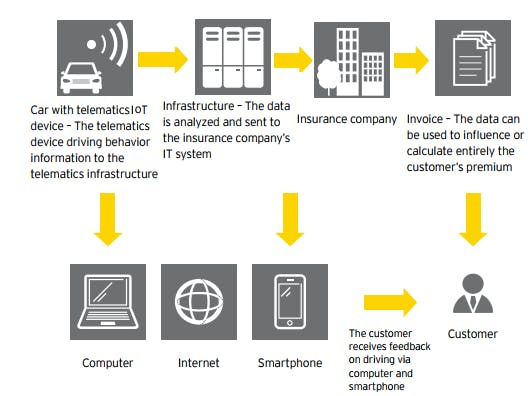Already, telematics or black box technology collects driving data, such as speed, distance and time of day, which is then fed back to the insurer to help calculate premiums. It is through the use of telematics that insurers are able to collect driving data enabling them to monitor and connect a driver’s individual risk with premium. Data has traditionally been one of insurance industry’s greatest and more valuable assets. The ubiquity of wireless connectivity, the increasing sophistication of in-vehicle electronics and machine-to-machine (M2M) communication is presenting the auto insurance industry with a historic transformational challenge.
This information and more could be transmitted in real time, giving a completely accurate picture of driver behaviour. IOT is the latest tool in telematics, with the devices linked to vehicles’ systems to transmit a variety of information to and from the car.
The data from a IOT tells us:
- the time of day or night you drive
- the speed you drive at on different sorts of roads
- if you brake or accelerate sharply
- if you take breaks on long journeys
- your motorway miles
- your total mileage
- the pressure
With premiums based on real-life activity, Usage Based Insurance (UBI), such policies could prove popular, as many drivers could see their premiums fall. Instead of basing insurance premiums on a vehicle's make and model, the age of driver, their experience and history on the road, UBI assess premiums based upon time of usage, distance driven, driving behavior and places driven to.
Meanwhile, when accidents do occur, it will become far easier to work out who is at fault. Insurance companies will be able to establish the precise movements of each car, combining behavioural data, such as hard braking and accelerating, with real-time contextual data, including road conditions and the weather, and even video from on-board cameras.
Pricing schemes can include Pay How You Drive (PHYD) - insurance premium is calculated based on how the vehicle is driven Pay As You Drive (PAYD) - insurance premium is calculated dynamically, typically according to the amount driven.
Benefits to Customers • Access to rewards such as premium discounts or access to partner benefits (e.g. garage membership, gas station, etc.) • Demonstrate safe driving habits following an accident • Enjoy value-added services, including: • Teen driver monitoring • Emergency services • Navigation/infotainment • Stolen vehicle recovery • Vehicle diagnostics.
Benefit to Insurers: Correct risk mis-classifications • Enhance pricing accuracy • Attract favorable risks • Retain profitable accounts • fight fraudulent claims • Reduce claim costs • Enable lower premiums • Replace proxy variables with intuitive variables directly related to loss exposure • Differentiate brand • Market environmentally friendly programs .
Benefit to Environment • Reduce accident frequency and severity (e.g., via driver incentives and education) • Reduce accident response time • Track and recover stolen vehicles • Establish fault to improve equity in settling claims • Reduce driving, pollution, traffic congestion and energy consumption.



Comments
Please log in or sign up to comment.